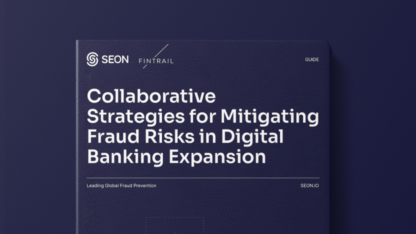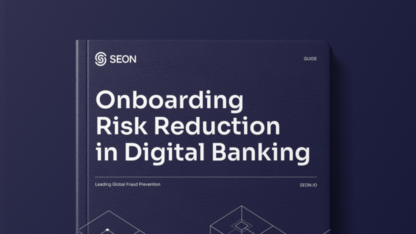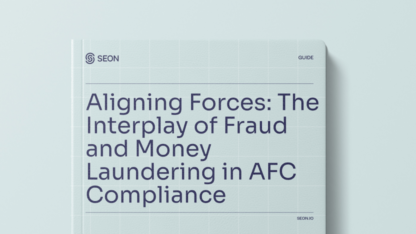Digital payments have revolutionized business operations, offering opportunities but exposing companies to advanced fraud risks. Valued at $3.53 trillion in 2018, the global digital payment market is expected to reach $19.89 trillion by 2026, highlighting the need for advanced fraud detection strategies to match this rapid growth.
Emerging threats require proactive, intelligent anti-fraud solutions that evolve with new tactics while staying efficient and user-friendly. To meet the demand for seamless prevention, the industry has developed innovative tools featuring cutting-edge technology, streamlined processes, and real-time adaptability.
Key Features of Fraud Detection Software
Effective fraud detection software combines multiple technologies into a single, seamless system. The best solutions enhance security, improve efficiency, and adapt to evolving threats. Here are the key features that define modern fraud prevention:
- All-in-One fraud protection: Combines fraud detection and AML tools in one platform, reducing the need for multiple systems. This improves teamwork and strengthens security.
- Live risk monitoring: Tracks digital footprints in real time using trusted data sources. Analyzes devices, emails, phones, and IPs while ensuring compliance with sanctions and watchlists.
- Clear AI-driven insights: AI-generated rules that provide easy-to-understand explanations, so managers can trust fraud detection decisions without relying on complex algorithms.
- Flexible, adaptive security: Adjusts quickly to new fraud threats and business needs with customizable rules, keeping businesses compliant with changing regulations.
- Quick and easy integration: Deploys fast with minimal setup, making fraud prevention seamless without disrupting business operations.
Top 12 Fraud Detection Software Companies
Disclaimer: All information in this article is based on publicly available sources gathered through online research. We haven’t tested each tool directly. The content was last updated in Q2 2025. If you spot anything outdated or would like to suggest an update, feel free to get in touch.
SEON
SEON is the leading fraud prevention and anti-money laundering solution, transforming how top-tier risk teams fight fraud. Founded initially to solve fraud problems in the crypto space, the company has evolved to protect over 5,000 global companies, including Afterpay, Revolut, Wise, Bilt and Branch.
SEON uses real-time digital footprint, device intelligence, and a customizable AI-driven rules engine to help businesses detect and prevent threats. Specializing in iGaming, fintech, financial services, and ecommerce, SEON has prevented $200 billion in fraud. It is highly trusted, with over 300 positive reviews on G2, Capterra, and the AWS Marketplace.
SEON’s Features
- Solution: SEON delivers end-to-end fraud and AML protection with custom-built tech that streamlines collaboration, boosts efficiency, and cuts costs across teams.
- Extensive real-time data: SEON delivers real-time insights from 300+ digital sources, device intelligence, IP and BIN lookups, card checks, and AML screening. It centralizes key data to detect patterns and prevent fraud and money laundering.
- Transparent, AI-driven insights: SEON blends blackbox AI with transparent models to spot emerging threats and deliver clear, actionable insights. This lets you understand detection logic and adapt with human-readable, AI-suggested rules.
- Adaptable and customizable risk rules: SEON provides customizable risk rules tailored to your regulatory needs, enabling you to build unlimited rules. This flexibility keeps your fraud and AML defenses strong as your business evolves.
- Speedy integration: SEON simplifies integration with a single API connection. Our dedicated customer support ensures a quick, smooth setup and provides tailored assistance to help you fully utilize the platform and address any concerns.
SEON’s fraud detection platform not only meets the diverse needs of fraud and compliance teams but also turns fraud detection into a strategic advantage, enhancing competitiveness in the market.
Read More About our Reviews on G2
Partner with SEON for AI-powered fraud prevention and AML. Stop threats, streamline risk, and gain real-time insights—trusted by 5,000+ companies
Speak with an Expert
Feedzai
Feedzai is a fraud detection platform designed for banks and PSPs, offering AI-driven risk assessment, behavioral analytics, and explainable decision-making. Its 2025 acquisition of Demyst enhanced access to external data, accelerating fraud detection and improving customer onboarding. The unified RiskOps platform applies contextual intelligence from identity, credit, and behavior for greater accuracy.
Founded by data scientists and aerospace engineers, Feedzai supports global banks and retailers in preventing and remediating fraud. It unifies fraud and AML capabilities to combat financial crime while enhancing operational efficiency and customer trust.
TruValidate
After acquiring iovation in 2018, TransUnion rebranded it as TruValidate, expanding its fraud prevention offering. TruValidate combines device recognition, identity and transaction analysis to deliver accurate, multi-layered fraud detection. It links proprietary and personal data, device identifiers, and online behavior to assess risk and detect anomalies.
With tools like TruVision, TruIQ, TruEmpower, TruLookup, TruAudience, and TruContact, it supports fraud prevention, risk scoring, credit insights, and more. TruValidate helps businesses protect customers, reduce false positives, and deliver friction-right, personalised experiences across key industries, including finance, insurance, and tenant screening.
ThreatMetrix
ThreatMetrix, part of LexisNexis Risk Solutions since 2005, specializes in user identity verification through behavioral analytics and global shared intelligence, leveraging over 78 billion data points. Designed for large organizations with technical infrastructure, it integrates seamlessly with other LexisNexis tools.
Its flexible platform supports near real-time verification, custom risk rules, and scalable fraud prevention. On-site support and a unified ecosystem make ThreatMetrix a strong option for enterprises seeking advanced, adaptable protection across the digital customer journey.
Sift
Sift provides tailored fraud prevention solutions for industries like retail, food and beverage, travel, and ticketing. Its Digital Trust & Safety Suite is designed to reduce losses, enhance operational efficiency, and protect the entire customer journey. Sift’s real-time decisioning and dynamic friction capabilities help businesses deliver secure and seamless experiences.
With tools like Payment Protection, Content Integrity, Account Defense, and Dispute Management, Sift supports scalable, AI-driven fraud prevention. Trusted by brands like, DoorDash, and Yelp, Sift enables enterprises to grow fearlessly while safeguarding digital trust.
FICO
FICO Falcon Fraud Manager is a fraud detection and prevention platform designed for financial institutions. It uses AI and machine learning to assess transactions in real time, helping to identify and address potentially suspicious activity across various payment types and channels.
The solution includes pre-configured fraud models and a flexible rules engine to support different operational needs. This description is based on publicly available information from FICO’s official site as of Q2 2025 and is intended for informational and comparative purposes only.
Emailage
Acquired by LexisNexis in 2020, Emailage is a fraud prevention solution that leverages global email intelligence to deliver real-time risk assessments. It combines LexisNexis’ Digital Identity Network with proprietary email data, enabling businesses to make faster, more informed decisions while enhancing user experience.
Emailage provides predictive fraud risk scoring powered by blackbox machine learning and enriched by behavioral patterns, email history, and identity signals. It supports use cases like account opening, CNP transactions, guest checkouts, and account management, helping over 2,000 businesses worldwide reduce fraud, improve approval rates, and streamline customer journeys.
Quantexa
Quantexa is a fraud detection and decision intelligence company that helps organizations uncover hidden risk and respond to complex fraud threats. By connecting internal and external data, Quantexa builds accurate, 360-degree views of entities and their relationships.
This contextual approach reduces false positives, accelerates investigations, and improves fraud detection across banking, insurance, government, and more. With flexible analytics, advanced AI, and proven results, Quantexa empowers teams to identify fraud faster and make smarter, risk-informed decisions at scale.
Kount
Kount helps businesses prevent fraud, verify identities, and increase transaction approvals using AI-driven technology and global data insights. Its platform offers advanced fraud detection, device fingerprinting, IP tracking, transaction scoring, and real-time analytics to reduce risk and enhance customer trust.
Kount’s product suite includes Kount 360 for AI-based payment risk management, Command for card-not-present transactions, Central for credit card payment workflows with PSPs, and Control for protecting accounts from takeover attempts. It also offers a chargeback management tool and a device module that gathers data from user hardware and software. Kount integrates with platforms like WooCommerce, Magento, and Shopify, making it adaptable to various business environments.
SAS
SAS Fraud Management is a comprehensive, real-time platform designed to help organizations detect and prevent fraud across multiple channels. It combines advanced analytics and machine learning to deliver fast, accurate decisions that adapt to evolving threats.
Built for scalability, the platform enables enterprise-wide monitoring and supports seamless data integration to improve risk detection and operational efficiency. By reducing false positives and speeding up response times, it helps businesses protect revenue, ensure compliance, and deliver a smoother customer experience. Recognized by industry analysts, SAS is a trusted choice for organizations looking for reliable, data-driven fraud prevention.
Abrigo
Abrigo offers fraud detection and financial crime prevention software as part of its broader risk management suite tailored for financial institutions. Positioned primarily for U.S.-based banks and credit unions, the platform integrates AML/BSA compliance tools with data analytics and automation to help mitigate operational and fraud risks.
While its core strengths lie in regulatory compliance and lending technology, Abrigo also provides advisory services and support. The company’s solutions are used by over 2,400 institutions, reflecting its established presence in the banking sector.
Forter
Forter offers an identity-based fraud prevention platform designed to protect digital commerce at every stage of the customer journey. Its solutions help detect fraud in real time, secure user accounts, optimize payment approvals, and manage chargebacks and abuse.
Forter’s approach is powered by a large identity graph and machine learning models trained on a vast global dataset. This description is based on publicly available information from Forter’s official site and is intended for informational and comparative purposes only.
How to Choose a Fraud Detection Software
Choosing the right software is a strategic decision. It should meet your needs now, scale with growth, and integrate smoothly with your operations.
Here are key factors to consider for effective risk management:
- Detection features: It’s crucial to ensure the software provides the necessary features to combat specific types of fraud, such as identity theft, payment fraud, or unauthorized account access. Tailor your choice to address your most pressing fraud concerns.
- Integration flexibility: Although many fraud detection systems are offered as Software as a Service (SaaS), depending on your company’s infrastructure and security requirements, on-premise integration might be necessary.
- Payment model: Avoid lengthy contracts that may not be cost-effective in the long run. Opt for a solution that offers a trial period or a short-term payment option to evaluate the software’s effectiveness before making a long-term commitment.
- Support and documentation: Confirm that the vendor provides comprehensive customer support and free assistance, particularly during the software integration phase. The availability of clear, detailed documentation is essential, allowing you to resolve issues independently without constant reliance on customer support.
Unsure whether to build or buy a fraud solution? Our guide compares costs, scalability, and long-term impact to help you decide.
Download Guide
Related Case Studies
- SEON: Revolut Leverages SEON’s Anti-Fraud Platform With Great ROI
- SEON: LeoVegas Boosts Fraud Detection by 10% and Enhances Analyst Efficiency with SEON
- SEON: Mokka Dropped Their Fraud Rates by Over 65%
Frequently Asked Questions
Fraud detection software is designed to automatically stop online fraud. The software analyses online user actions and, based on your risk rules, blocks those that are deemed high risk.
A high-risk user action can be a payment, signup, or login, among others. The fraud detection software must be setup to analyse user or payment data, analyse that data via risk rules, and decide if it is risky or not.
To choose the right fraud detection software, start by assessing your company’s fraud risks, existing security tools, and risk tolerance. Key features to look for include customizable risk rules, device fingerprinting, alternative data scoring, real-time analysis, and machine learning for automation.
Today, all businesses are at risk from fraud, no matter their sector. In fact, the current fraud landscape demonstrates that those companies and decision-makers who think they couldn’t be affected are more likely to be targeted – exactly because they are less likely to invest in their defenses.
The decision to build or buy fraud detection software depends on your company’s resources, priorities, and long-term strategy. Building a solution offers full control but requires significant investment, technical expertise, and ongoing maintenance. Buying an end-to-end platform provides faster deployment, scalability, and access to regularly updated fraud models—often at a lower long-term cost.








